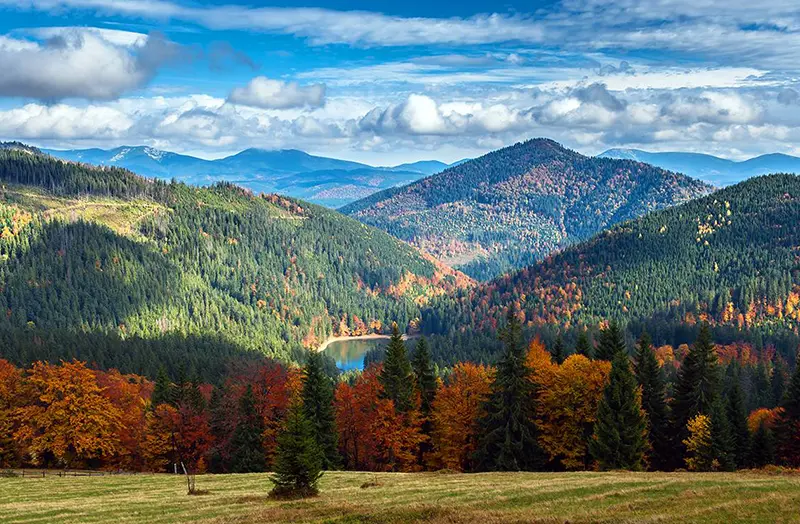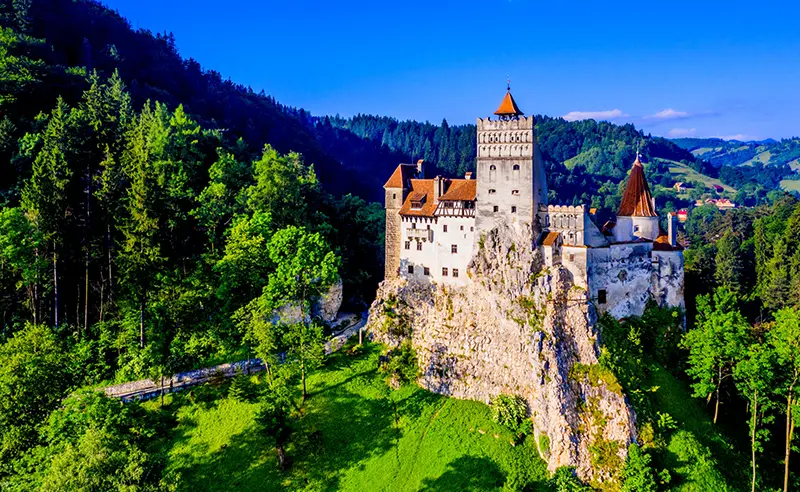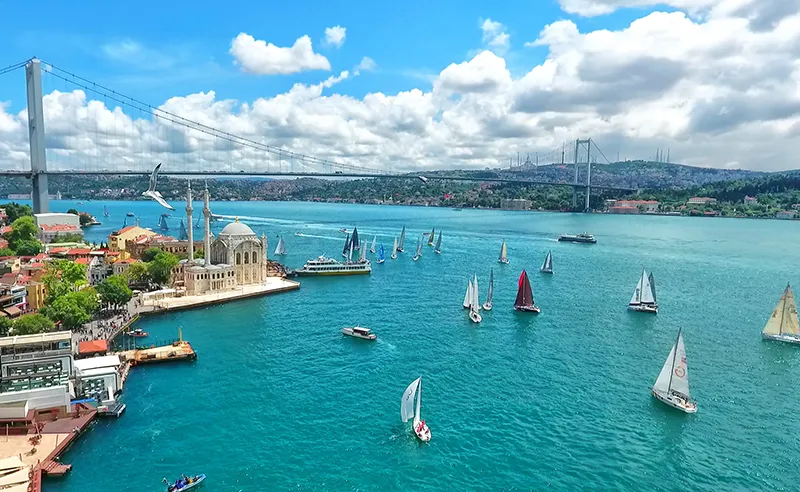The Carpathian Mountains are a picturesque mountain range stretching through several countries of Eastern Europe. It is a land of dense forests, alpine meadows, cleanest rivers and thermal springs. The Carpathians are known for their mild climate, rich flora and fauna, as well as the original culture of local peoples. Here you can find solitude in the wilderness, enjoy ski resorts or hike along ancient trails.
History of the Carpathian Mountains
According to many scientists, the richest gold deposits in Europe were in the Carpathians. Mining of the precious metal began here in the VII-VI centuries B.C. The gold-bearing area, where there were both native and scattered deposits, was called Dacia during the Roman rule, and in the Middle Ages and later – Transylvania.
A Thracian people of Indo-European origin, the Dacians formed their state in this area. Besides mining gold, silver, iron and salt, which were rich in the Carpathians, the Dacians were engaged in agriculture on the fertile soils of the mountain valleys and grazing on the alpine meadows of the Carpathians They also made devastating raids on foreign lands.
The need to defend themselves against barbarian raids was declared by the Romans as the main reason for the Dacian wars. But most likely, the main reason was the riches of the Carpathians, which the Romans knew about, some Dacian mines of gold, silver, iron were the largest in Europe.
At first success went with the Dacians and their king Decebalus. In 86 he defeated the Roman governor Oppius Sabinus, and in 87 he defeated the legions of the Roman emperor Domitian. But in 88 Decebalus was defeated by the general Julian. However, the Romans then had to conclude a peace favorable to Decebalus.
The destroyer of the kingdom of the Dacians was the emperor Trajan, who attacked Dacia in 101. As a result of hard fighting and numerous losses on both sides, a peace was concluded in 102, making Decebalus dependent on Rome. In 105 Trajan invaded Dacia again, defeated Decebal’s army and in 106 destroyed the capital of Dacia, Sarmizegetusa. Decebalus committed suicide.
In 106 a new Roman province, Roman Dacia, was formed. In 50 kilometers from the former Dacian capital there was a new capital Ulpia Trajan. In honor of the conquest of Dacia was minted a special gold coin – areus, with the portrait and title of Trajan on the obverse side and the goddess Victoria at the shield with the inscription “Dacia” on the reverse side. From Dacia to Rome was delivered such a quantity of gold that on 106 in the Roman Empire were canceled all taxes, and each citizen was given 650 denarii. The white marble column of Trajan with scenes of Dacian-Roman wars, preserved in Rome, is still a reminder of this victory.
The Romans founded towns and paved roads in the new province. Much of this has survived to this day, such as the Romanian city of Cluj-Napoca, which was founded as a Roman legion base. The troops of the Empire guarded the mines and ensured the transportation of valuable goods to Rome. The large gold mines of Dacia became the property of the Roman emperor and were controlled by the imperial procurator.
Archaeologists still find in old mines Roman coins and even mine lamps with Latin inscriptions. According to historians, from Dacia to Rome annually came several tons of gold. The province of Dacia also supplied Rome with iron, lead, copper, silver and salt.
In Roman times the Carpathians also received their modern name. The Dacian tribe of the Carps, which remained independent, formed a strong military alliance with the Goths in the 3rd century and engaged in a series of military clashes with the Romans. In 295-297 the Carps were defeated. The importance of these successes for Rome is confirmed by the fact that five Roman emperors, from Diocletian to Constantine the Great, added the title Carpicus Maximus to all their other titles.
The Roman Empire fought for the opportunity to mine the ore riches of the Carpathians to the last possible opportunity.
Legends of the Carpathians
The Carpathian Mountains are among the oldest mountains, approximately 1.2 billion years old. Starting near Bratislava (Slovakia) and ending at the Iron Gate in Romania, the Carpathians form an arc almost 1500 km long and cover the Central European Plain on three sides.
Ancient forests unique for central Europe have been preserved here, and the mountains are mostly plateaus – flat, without rocky ledges. The Carpathians are one of the main watersheds of Europe, which separates the rivers of the Vistula and Odra basins, which give water to the Baltic Sea, and the rivers of the Danube and Dniester basins.
And the Carpathians are also a place where many peoples have for centuries created legends of wonders and horrors, where, as fairy tales tell us, extraordinary creatures and ancient mystical forces live. Folk legends populate the Carpathians with dragons, forest spirits, sorcerers and vampires.
One of the most famous characters of Carpathian legends is Count Dracula, who has become a household name with the light hand of the Irish writer Bram Stoker (1847-1912), author of the novel “Dracula”. Based on this novel and its motives, countless movies have already been made about the vampire, who lives forever by killing people, drinking their blood, and has incredible power.
However, the protagonist of Stoker’s novel had a prototype – the lord of Wallachia Vlad III (1431-1476), nicknamed Tepes, or Stakeholder, because he preferred to execute his opponents by putting them on a stake. Another name – Dracula (son of the Dragon) Vlad III received thanks to his father, who was a member of the Order of the Dragon, created by Holy Roman Emperor Sigismund. Vlad II bore the nickname Dracul, which translates to “dragon” or even “devil”.
The real Vlad III was sent as a child to Istanbul as a hostage of his father’s loyalty to the Ottoman Empire, and at the age of 17 learned that his father and older brother had been murdered by Wallachian boyars. So Dracula had little reason to cultivate a meek temperament. All his short life (he lived 45 years) – fighting with Turks, Hungarians, local boyars, 12 years of imprisonment in a Hungarian prison – did not dispose to good deeds.
It is quite possible that most of the terrible stories about Tepes are fiction. The document, which lists the crimes of the Valash gentleman, was published in Germany in 1463. Just in that year Vlad III was fraudulently imprisoned by the Hungarian king. Therefore, the stories about how 500 boyars were innocently staked and many beggars were burned alive, or about how the lord personally cut open the belly of his mistress are highly doubtful. If we take into account that before that Vlad III defeated 30 thousand Turkish army of Sultan Mehmed II, and with the great support of his people peasants and townspeople, it becomes clear that, most likely, King Matyash Korvin needed to justify the illegal captivity of the neighboring lord, and the slander was used.
Of course, Vlad Tepes was cruel, but he hardly surpassed his contemporaries in this. However, it was he who was destined to become the prototype of the most terrible vampire of world literature – Count Dracula. Today Bran Castle, 30 kilometers from Brasov, where Dracula supposedly lived, is the most famous tourist object in Romania. In fact, the real Tepes only occasionally came here. By the way, it was he who founded Bucharest (1459), near which he took his last battle with the Turks.
But the legend already lives separately from the real person – and all new variants of mystical crimes of the Count Vampire continue to frighten and entertain the public all over the world.
General information
- Carpathians, mountain system in Central Europe.
- States where the Carpathians are located: Slovakia, Hungary, Poland, Ukraine, Romania, Serbia, Austria.
- The largest cities: Sibiu, Cluj-Napoca, Tirgu-Mures, Baia-Mare (Romania), Zakopane, Krosno (Poland), Uzhgorod (Ukraine), Kosice (Slovakia), Miskolc (Hungary).
- The most important airports: Baja Mare International Airport, Transylvania Airport (Târgu-Mures), Kosice-Bartsa Airport, Uzhgorod International Airport.
- The largest rivers: Danube, Dniester.
- The largest lakes: Morskoye Oko, Red Lake, Skalnoye Oko.
- Length: 1500 km.
- Width: 250 km (north-west), about 120 km (central part of the mountain range), up to 430 km (in the south-east).
- Highest point: Gerlachovský Štít (Slovakia), 2655 m.
Climate and weather
- Temperate, transitional from maritime to continental.
- Average January temperature: from -5ºC (north of the Carpathians) to -3ºC (south).
- Average July temperature: +17ºC (north) and +20ºC (south).
- Average annual precipitation: 600 to 1000 mm.
- In the highland belt: 1200 to 2000 mm.
Economy
- Extraction of minerals – oil and gas, table and potassium salt, ozokerite, marble, hard and brown coal, iron and manganese ores.
- Shipping, hydroelectric power engineering.
- Service sector: tourism, climatic and ski resorts.
Attractions
- Uzhgorod (Ukraine): Transcarpathian Museum of Architecture and Life, Museum of Local Lore, Art Museum, Zoological Museum, cathedral, castle-fortress;
- Košice (Slovakia): Old Town, St. Alzbieta Cathedral (tomb of Ferenc Rakoczy), Urbana Tower, St. Michael’s Church, Plague Column, Miklusova Važnica Prison, Museum of Eastern Slovakia, Zoological Museum;
- Prešov (Slovakia): Church of St. Nicholas, Evangelist Church. Museum of Wine, Museum of Prešov;
- Šarišské – Slovak ethnographic open-air museum;
- Spišská Kapitula Abbey (Slovakia);
- Banska Bistrica (Slovakia): Fortress Church, Church of the Holy Cross, Old Castle, medieval houses;
- Miskolc: Museum of Scythian culture and Bronze Age objects;
- Alba Iulia (Romania): Museum of Romania, Citadel, cathedral, princely palace. Museum of gold mines (Roşia-Montane), glacial cave (Scărişoare);
- Brasov (Romania): Ruins of the citadel, Church of St. Nicholas, Church of Biseric-Niagre, Church of St. Bartholomew, Historical Museum, Town Hall, 17th- and 18th-century houses;
- Bran Castle (Museum of Feudal Art) (Romania);
- Rishnov Castle (Romania);
- Cluj-Napoca (Romania): St. Michael’s Church, Reformed Church, Banfi Palace (Museum of Art), City Museum, Ethnographic Museum of Transylvania;
- Sighisoara (Romania): Old Town. Mountain Church, Clock Tower, medieval houses;
- Timisoara (Romania): Hunyazov Castle, Cathedral of the Orthodox Metropolis (Museum of Medieval Art);
- Carpathian Biosphere Reserve (Daffodil Valley) (Ukraine);
- Carpathian National Nature Park (Ukraine);
- Bicaz Gorge (Romania);
- Djerdal National Park (Serbia).
Fun Facts
- Not far from the Romanian town of Târgu-Okna in an ancient salt mine at a depth of 240 meters is the largest underground sanatorium in Europe.
- In 2002, in the Romanian Carpathians, in the so-called Cave of Bones, the remains of the oldest European belonging to the species “man of reason” were found. Radiocarbon analysis of the bones gave the result: the age of the bones – from 34 to 36 thousand years. It was even possible to reconstruct the appearance of the ancient man – it turned out that in his appearance there are features of different races.
- The World Heritage Committee included the virgin beech forests of the Carpathians in the UNESCO World Heritage List. These forests are located on the territory of two countries – Ukraine and Slovakia and represent a chain of ten reserves.




